Question 1
The diagram shows part of the graph of `y=a(x-h)^2+k`. The graph has its vertex at `P`, and passes through the point `A` with coordinates `(1,0)`.

(a) Write down the value of
(i) `h`;
(ii) `k`.
(b) Calculate the value of `a`.
Mark as Complete
Mark Scheme
Question 2
Consider the following function:
`h(x)=2/(sqrt(x-1))+1/2," for " x>1.`
(a) Find `h^(-1) (1)`
(b) Find the domain of `h^(-1) (x)`
Mark as Complete
Mark Scheme
Question 3
The diagram shows part of the graph of the curve `y=a(x-h)^2+k`, where `a,h,k∈Z`
(a) The vertex is at the point `(3,1)`. Write down the value of `h` and of `k`.
(b) The point `P(5,9)` is on the graph. Show that `a=2`.
(c) Hence show that the equation of the curve can be written as `y=2x^2-12x+19.`
(d) (i) Find `dy/dx`
A tangent is drawn to the curve at `P(5,9)`
(ii) Calculate the gradient of this tangent.
(iii) Find the equation of this tangent.
Mark as Complete
Mark Scheme
Question 4
(a) The diagram shows part of the graph of a quadratic function `f(x)=x^2+bx+c`, which intersects the x-axis at `x=2` and at `x=3`
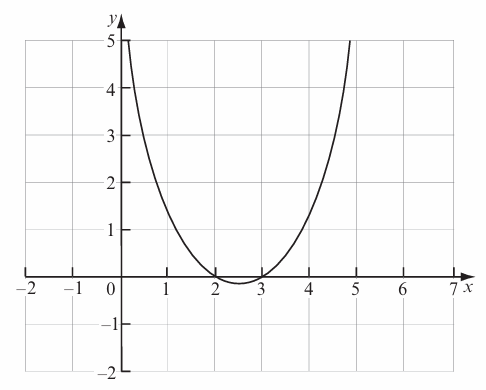
Find the value of `b` and of `c`
(b) The diagram shows part of the graph of another quadratic function `g`. It can be written in the form `g(x)=a(x-h)^2+3`. Its vertex is at `(2,3)` and its y-intercept is `5`.
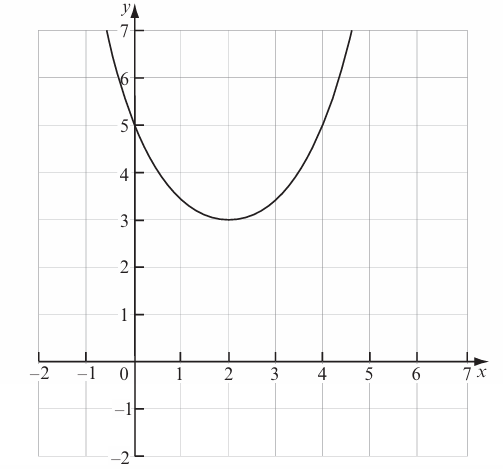
(i) Write down the value of `h`
(ii) Find the value of `a`
Mark as Complete
Mark Scheme
Question 5
The following diagram shows part of the graph of `f`, where `f(x)=x^2-x-2`
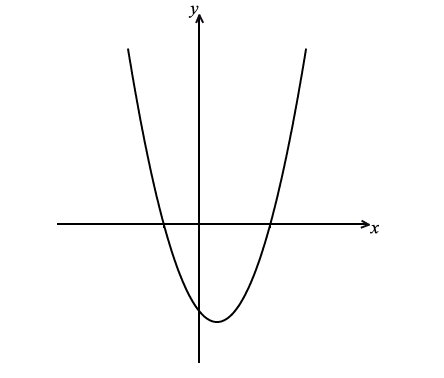
(a) Find both x-intercepts.
(b) Find the x-coordinate of the vertex.
Mark as Complete
Mark Scheme
Question 6
A function `f` is defined by `f(x)=(2x-1)/(x+1)`, where `x∈R,x≠-1`
(a) The graph of `y=f(x)` has a vertical asymptote and a horizontal asymptote.
Write down the equation of
(i) The vertical asymptote;
(ii) The horizontal asymptote.
(b) On the set of axes below, sketch the graph of `y=f(x)`
On your sketch, clearly indicate the asymptotes and the position of any points of intersection with the axes.

(c) Hence, solve the inequality `0<(2x-1)/(x+1)<2`
Mark as Complete
Mark Scheme
Question 7
Let `f(x)=p(x-q)(x-r)`. Part of the graph of `f` is shown below.
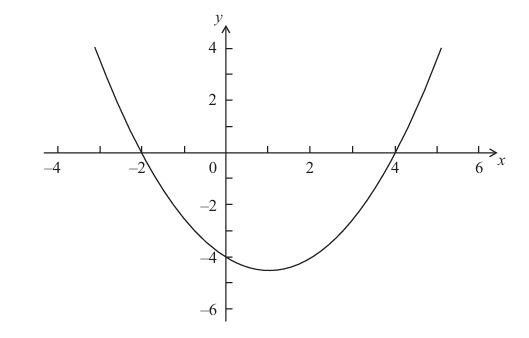
The graph passes through the points `(-2,0)`, `(0,-4)` and `(4,0)`
(a) Write down the value of `q` and of `r`
(b) Write down the equation of the axis of symmetry.
(c) Find the value of `p`
Mark as Complete
Mark Scheme
Question 8
Let `f(x)=1/2 x^2+kx+8`, where `k∈Z`
(a) Find the values of `k` such that `f(x)=0` has two equal roots.
(b) Each value of `k` is equally likely for `-5≤k≤5`. Find the probability that `f(x)=0` has no roots.
Mark as Complete
Mark Scheme
Question 9
Let `f` be a quadratic function. Part of the graph of `f` is shown below.
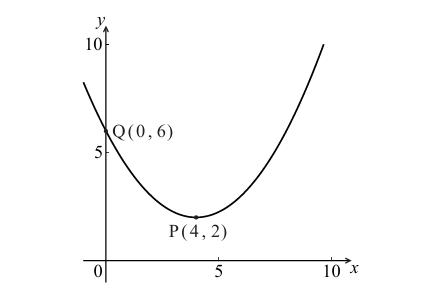
The vertex is at `P(4,2)` and the `y`-intercept is at `Q(0,6)`
(a) Write down the equation of the axis of symmetry.
The function `f` can be written in the form `f(x)=a(x-h)^2+k`
(b) Write down the value of `h` and of `k`.
(c) Find `a`
Mark as Complete
Mark Scheme
Question 10
A function `f` is defined by `f(x)=(2(x+3))/(3(x+2))`, where `x∈R,x≠-2`
The graph `y=f(x)` is shown below.
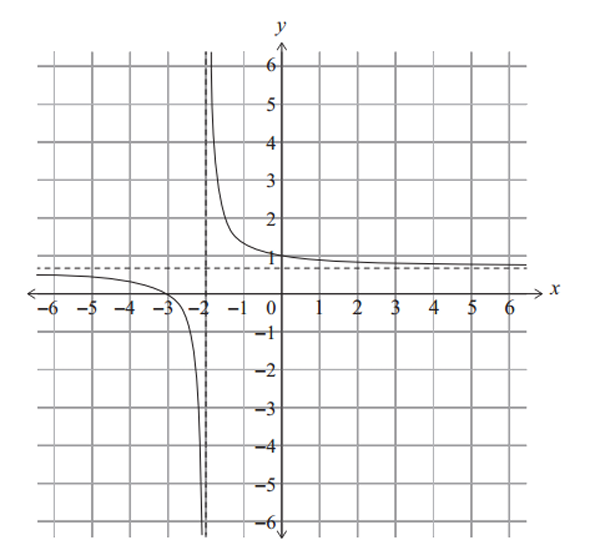
(a) Write down the equation of the horizontal asymptote.
Consider `g(x)=mx+1`, where `m∈R,m≠0`
(b) (i) Write down the number of solutions to `f(x)=g(x)` for `m>0`
(ii) Determine the value of m such that `f(x)=g(x)` has only one solution for `x`
(iii) Determine the range of values for `m`, where `f(x)=g(x)` has two solutions for `x≥0`
Mark as Complete
Mark Scheme
Question 1
The diagram shows part of the graph of `y=a(x-h)^2+k`. The graph has its vertex at `P`, and passes through the point `A` with coordinates `(1,0)`.

(a) Write down the value of
(i) `h`;
(ii) `k`.
(b) Calculate the value of `a`.
(a) (i) `h=-1`
(ii) `k=2`
(b) `a(1+1)^2+2=0`
`a=-0.5`
Question 2
Consider the following function:
`h(x)=2/(sqrt(x-1))+1/2," for " x>1.`
(a) Find `h^(-1) (1)`
(b) Find the domain of `h^(-1) (x)`
(a) setting `h(x)=1`
`h^(-1) (1)=17`
(b) `x>1/2`
Question 3
The diagram shows part of the graph of the curve `y=a(x-h)^2+k`, where `a,h,k∈Z`
(a) The vertex is at the point `(3,1)`. Write down the value of `h` and of `k`.
(b) The point `P(5,9)` is on the graph. Show that `a=2`.
(c) Hence show that the equation of the curve can be written as `y=2x^2-12x+19.`
(d) (i) Find `dy/dx`
A tangent is drawn to the curve at `P(5,9)`
(ii) Calculate the gradient of this tangent.
(iii) Find the equation of this tangent.
(a) Since the vertex is at `(3,1)`
`h=3`
`k=1`
(b) `(5,9)` is on the graph
`⇒9=a(5-3)^2+1`
`=4a+1`
`⇒9-1=4a=8`
`⇒a=2`
(c) `y=2(x-3)^2+1`
`=2x^2-12x+19`
(d) (i) Graph has equation `y=2x^2-12x+19`
`dy/dx=4x-12`
(ii) At point `(5,9)`, gradient `=4(5)-12=8`
(iii) Equation: `y-9=8(x-5)`
`8x-y-31=0`
Question 4
(a) The diagram shows part of the graph of a quadratic function `f(x)=x^2+bx+c`, which intersects the x-axis at `x=2` and at `x=3`

Find the value of `b` and of `c`
(b) The diagram shows part of the graph of another quadratic function `g`. It can be written in the form `g(x)=a(x-h)^2+3`. Its vertex is at `(2,3)` and its y-intercept is `5`.

(i) Write down the value of `h`
(ii) Find the value of `a`
(a) `b=-5, c=6`
(b) (i) `h=2`
(ii) `g(x)=a(x-2)^2+3`
`5=a(0-2)^2+3`
`a=0.5`
Question 5
The following diagram shows part of the graph of `f`, where `f(x)=x^2-x-2`

(a) Find both x-intercepts.
(b) Find the x-coordinate of the vertex.
(a) evidence of attempting to solve `f(x)=0`
evidence of correct working
e.g. `(x+1)(x-2), (1±sqrt9)/2`
intercepts are `(-1,0)` and `(2,0)` (accept `x=-1, x=2`)
(b) evidence of appropriate method
e.g. `x_v=(x_1+x_2)/2, x_v=(-b)/2a`, reference to symmetry
`x_v=0.5`
Question 6
A function `f` is defined by `f(x)=(2x-1)/(x+1)`, where `x∈R,x≠-1`
(a) The graph of `y=f(x)` has a vertical asymptote and a horizontal asymptote.
Write down the equation of
(i) The vertical asymptote;
(ii) The horizontal asymptote.
(b) On the set of axes below, sketch the graph of `y=f(x)`
On your sketch, clearly indicate the asymptotes and the position of any points of intersection with the axes.

(c) Hence, solve the inequality `0<(2x-1)/(x+1)<2`
(a) (i) `x=-1`
(ii) `y=2`
axes intercepts clearly shown at `x=1/2` and `y=-1`
(b)
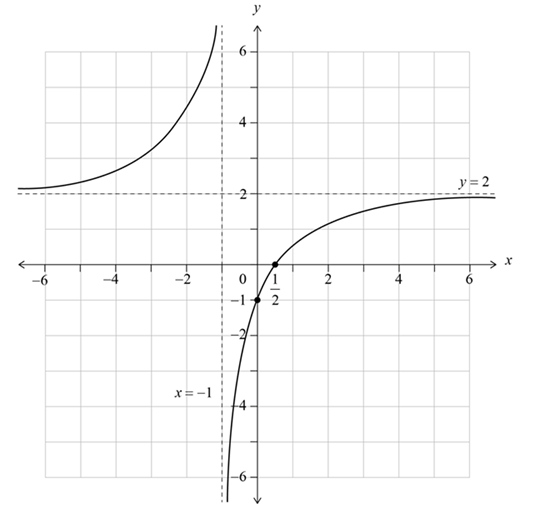
(c) `x>1/2`
Question 7
Let `f(x)=p(x-q)(x-r)`. Part of the graph of `f` is shown below.

The graph passes through the points `(-2,0)`, `(0,-4)` and `(4,0)`
(a) Write down the value of `q` and of `r`
(b) Write down the equation of the axis of symmetry.
(c) Find the value of `p`
(a) `q=-2, r=4` or `q=4, r=-2`
(b) `x=1` (must be an equation)
(c) substituting `(0,-4)` into the equation
e.g. `-4=p(0-(-2))(0-4)`, `-4=p(-4)(2)`
correct working towards solution
e.g. `-4=-8p`
`p=4/8 (=1/2)`
Question 8
Let `f(x)=1/2 x^2+kx+8`, where `k∈Z`
(a) Find the values of `k` such that `f(x)=0` has two equal roots.
(b) Each value of `k` is equally likely for `-5≤k≤5`. Find the probability that `f(x)=0` has no roots.
(a) Recognising that equal roots means perfect square
e.g. attempt to complete the square, `1/2(x^2+2kx+16)`
correct working
e.g. `1/2(x+k)^2, 1/2 k^2=8`
`k=±4`
(b) evidence of appropriate approach
e.g. `b^2-4ac<0`
correct working for `k`
e.g. `-4ltklt4`, `k^2 lt6`
`p=7/11`
Question 9
Let `f` be a quadratic function. Part of the graph of `f` is shown below.

The vertex is at `P(4,2)` and the `y`-intercept is at `Q(0,6)`
(a) Write down the equation of the axis of symmetry.
The function `f` can be written in the form `f(x)=a(x-h)^2+k`
(b) Write down the value of `h` and of `k`.
(c) Find `a`
(a) `x=4` (must be an equation)
(b) `h=4`, `k=2`
(c) attempt to substitute coordinates of any point on the graph into `f`
e.g. `f(0)=6, 6=a(0-4)^2+2, f(4)=2`
correct equation (do not accept an equation that results from `f(4)=2`
e.g. `6=a(-4)^2+2, 6=16a+2`
`a=4/16 (=1/4)`
Question 10
A function `f` is defined by `f(x)=(2(x+3))/(3(x+2))`, where `x∈R,x≠-2`
The graph `y=f(x)` is shown below.

(a) Write down the equation of the horizontal asymptote.
Consider `g(x)=mx+1`, where `m∈R,m≠0`
(b) (i) Write down the number of solutions to `f(x)=g(x)` for `m>0`
(ii) Determine the value of m such that `f(x)=g(x)` has only one solution for `x`
(iii) Determine the range of values for `m`, where `f(x)=g(x)` has two solutions for `x≥0`
(a) `y=2/3` (must be written as equation with `y=`)
(b) (i) `2`
(ii) `(2(x+3))/(3(x+2))=mx+1`
attempt to expand to obtain a quadratic equation
`2x+6=3mx^2+6mx+3x+6`
`3mx^2+(6m+1)x=0 "OR" 3mx^2+6mx+x=0`
attempt to solve their quadratic for `x` and equating their solutions
`x(3mx+6m+1)=0`
`x=0 "OR" x=(-6m+1)/3m (=0)`
`(-6m+1)/3m=0`
`⇒m=-1/6`
(iii) `-1/6ltmlt0`
Question 1
The diagram shows part of the graph of `y=a(x-h)^2+k`. The graph has its vertex at `P`, and passes through the point `A` with coordinates `(1,0)`.

(a) Write down the value of
(i) `h`;
(ii) `k`.
(b) Calculate the value of `a`.
Question 2
Consider the following function:
`h(x)=2/(sqrt(x-1))+1/2," for " x>1.`
(a) Find `h^(-1) (1)`
(b) Find the domain of `h^(-1) (x)`
Question 3
The diagram shows part of the graph of the curve `y=a(x-h)^2+k`, where `a,h,k∈Z`
(a) The vertex is at the point `(3,1)`. Write down the value of `h` and of `k`.
(b) The point `P(5,9)` is on the graph. Show that `a=2`.
(c) Hence show that the equation of the curve can be written as `y=2x^2-12x+19.`
(d) (i) Find `dy/dx`
A tangent is drawn to the curve at `P(5,9)`
(ii) Calculate the gradient of this tangent.
(iii) Find the equation of this tangent.
Question 4
(a) The diagram shows part of the graph of a quadratic function `f(x)=x^2+bx+c`, which intersects the x-axis at `x=2` and at `x=3`

Find the value of `b` and of `c`
(b) The diagram shows part of the graph of another quadratic function `g`. It can be written in the form `g(x)=a(x-h)^2+3`. Its vertex is at `(2,3)` and its y-intercept is `5`.

(i) Write down the value of `h`
(ii) Find the value of `a`
Question 5
The following diagram shows part of the graph of `f`, where `f(x)=x^2-x-2`

(a) Find both x-intercepts.
(b) Find the x-coordinate of the vertex.
Question 6
A function `f` is defined by `f(x)=(2x-1)/(x+1)`, where `x∈R,x≠-1`
(a) The graph of `y=f(x)` has a vertical asymptote and a horizontal asymptote.
Write down the equation of
(i) The vertical asymptote;
(ii) The horizontal asymptote.
(b) On the set of axes below, sketch the graph of `y=f(x)`
On your sketch, clearly indicate the asymptotes and the position of any points of intersection with the axes.

(c) Hence, solve the inequality `0<(2x-1)/(x+1)<2`
Question 7
Let `f(x)=p(x-q)(x-r)`. Part of the graph of `f` is shown below.

The graph passes through the points `(-2,0)`, `(0,-4)` and `(4,0)`
(a) Write down the value of `q` and of `r`
(b) Write down the equation of the axis of symmetry.
(c) Find the value of `p`
Question 8
Let `f(x)=1/2 x^2+kx+8`, where `k∈Z`
(a) Find the values of `k` such that `f(x)=0` has two equal roots.
(b) Each value of `k` is equally likely for `-5≤k≤5`. Find the probability that `f(x)=0` has no roots.
Question 9
Let `f` be a quadratic function. Part of the graph of `f` is shown below.

The vertex is at `P(4,2)` and the `y`-intercept is at `Q(0,6)`
(a) Write down the equation of the axis of symmetry.
The function `f` can be written in the form `f(x)=a(x-h)^2+k`
(b) Write down the value of `h` and of `k`.
(c) Find `a`
Question 10
A function `f` is defined by `f(x)=(2(x+3))/(3(x+2))`, where `x∈R,x≠-2`
The graph `y=f(x)` is shown below.

(a) Write down the equation of the horizontal asymptote.
Consider `g(x)=mx+1`, where `m∈R,m≠0`
(b) (i) Write down the number of solutions to `f(x)=g(x)` for `m>0`
(ii) Determine the value of m such that `f(x)=g(x)` has only one solution for `x`
(iii) Determine the range of values for `m`, where `f(x)=g(x)` has two solutions for `x≥0`